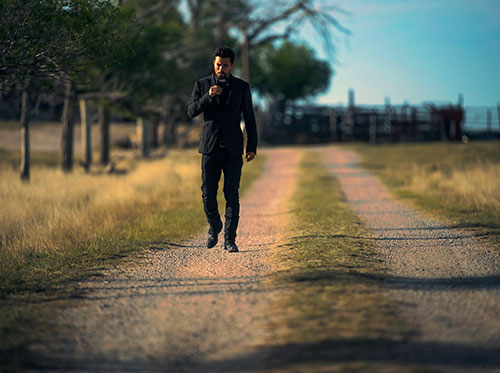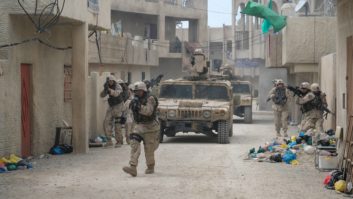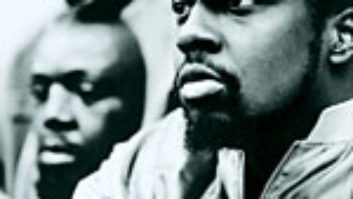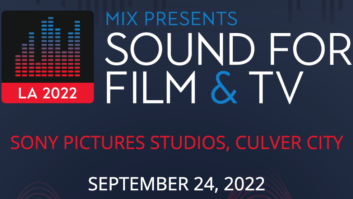
Preacher, AMC’s newest series adapted from a cult comic book, centers around a super-hot preacher man, Jesse Custer, his renegade Dorothy Dandridge-esque soulmate, Tulip, and their wacky vampire buddy, Cassidy. Custer has a gift, the power to make anyone do his bidding using the voice of the entity that is inhabiting his body, aka the voice of God. If bewilderment has already set in, that is understandable, as much of Preacher is confusing. Connections are made over the course of a few episodes, where if you pay super-close attention, things kind of start to make a little sense.
The post-production sound team has a lot to do with assisting in making these connections. Supervising sound editor Richard Yawn meets with the show’s executive producers, Seth Rogan and Evan Goldberg (This Is the End, Superbad, Neighbors), and showrunner Sam Catlin (Breaking Bad), during an initial spotting session. Here, Yawn takes copious notes on their very expressive ideas and concepts, as well as asks questions, makes suggestions and brings up ideas of his own. He then disseminates the information to his team, regarding sound design, music, effects, Foley, dialog and ADR. They then deliver to the re-recording team, which for a conventional-length episode has three days of mixing and a day of playback, which can stretch to five days total for extended episodes.

Joseph Gilgun as Cassidy. Photo: Lewis Jacobs/AMC
Dialog and music mixer Mark Linden—whose Emmy wins are quickly moving past being countable on two hands—says, “On Preacher, there is a lot of overlap between music and post because so much of the effects and design in the show cross in points where music is playing almost a sound design-type role. There is music that is tonal and really effected, and a lot of effects are musical and really tonal.
“The challenge with TV is to get dialog loud enough where in a suburban home it is heard over the ambience,” he continues. “The more you keep the dialog up, the more it limits how much you can do on sequences. We worked a ton getting the music to play with the effects and to maintain all of them so we could keep the dynamic hits and still have the dialog.”

Ruth Negga as Tulip O’Hare. Photo: Lewis Jacobs/AMC
This is another area of crossover, this time with Tara A. Paul, also a collector of Emmys, who mixes background, effects and Foley. For Preacher’s stylized filming, Foley has a more central role than it otherwise might.
“There was a lot of opportunity to play,” says Paul, who works side-by-side with Linden on one of the re-recording mix stages on the Sony Pictures lot in Culver City, Calif., both using Pro Tools and an Avid ICON D-Control ES mixing console. “I was able to change things with EQ and pitch shift. I rely pretty heavily on Pro Tools’ built-in 7-band parametric equalizer. As far as distortion goes, I like the Meequalizer. In the fifth episode, for instance, we are looking at a hole in the wall where every time someone passed by, we had to filter so it felt like we were hearing someone block the sound for a moment. I used the Meequalizer to roll off the top end and then roll it back up again. For reverb, I like the PhoenixVerb. It has a pleasant decay and a clean sound without that digital top end that a lot of reverbs get.

Tom Brooke (left) as Fiore and Anatol Yusef as DeBlanc. Photo: Lewis Jacobs/AMC
“I’m also using Fab Filter and the L1 compressor but not for limiting, which is what it’s intended for,” Paul continues. “I use it specifically to get a mightier sound out of things like gunshots that I don’t have the headroom for because of TV limitations. I compress the sounds enough so it adds a little bit of distortion, making the apparent sound much louder than the actual sound. That way I am able to keep within TV specs without pegging the meter but still give it that big feature sound.”
“You have to figure out a way to make something feel like it’s loud without hitting the frequencies that take up the bandwidth of the feature, but still have the impact,” Linden concurs. This is an area where the post team worked a lot with composer Dave Porter (Breaking Bad, Better Call Saul). “Each time we ran into the issue of not being able to make it any louder, [Porter] would come back with other frequencies. He’s very knowledgeable about the dynamics of sound versus instruments in a music piece. We were able to make a mix apparently loud without making it dynamically loud.”

Richard Yawn
A particular trait of Preacher’s is having sound that isn’t supported by picture. For instance, the character Quincannon, who runs a slaughterhouse, is in his office listening to tortured cows over the intercom. The viewer thankfully doesn’t see this, but hears it. Later, Quincannon is having somewhat of a Civil War reenactment when trying to make the preacher sign the church lease. Elsewhere, Eugene, another character, climbs out of hell (according to him, “It’s not that far”). The sound team comes up with the sounds of cow slaughter, war screams, and hell based on feeling without visual reference.

Tara Paul
“We want to morph from cow sounds to screaming sounds to hell sounds without giving away the story,” explains Linden. “The idea is to keep referencing back to concepts so each time you see Quincannon, you feel what his character was like. The music and sound design changes in the playback process a lot because there was no way for the producers to hear music completely against sound design. It was an ongoing thing with [Porter] having to write new cues. It wasn’t just melodic lines, but frequency lines that in some cases push accents into music or pull effects back. A lot of times we would re-mix scenes up to three times because the producers were hearing things for the first time.”
One of the signature sounds on Preacher is Custer’s voice of God, which has its own restriction issues. The voice was initially processed by Mike Babcock, who also put together its design elements. It is augmented by sound designer Steve Avila and, depending on the scene, reprocessed and treated in the mix stage for its unique combination of effects, voice and music. “The voice tends to be treated so it sits with everything else we do with a lot of pitching,” says Linden. “I relied a lot on Waves UltraPitch because you can set pitches and delays for each pitch. Again, the big issue is, how do you get it to play on the dynamic range of TV? I spread it around the room with a lot of pitches and delays so everything isn’t coming out of one speaker center with limited dynamic range. You get the big feel by imaging and pitching.”

Mark Linden
“When the preacher’s voice wants to command somebody,” Yawn explains, “on the effects side, we would have design elements working with the dialog side. The effects are modulated low-end working with the modulation of the dialog, creeping in and out and peaking with the dialog performances.”
This is apparent in the baby cry element and also an amniotic heartbeat that goes with the voice of God. Hearing those synthesized creates the idea of the theme for the viewer, either consciously or unconsciously. Another example is the character Saint of Killers, who has a three-part nightmare in the first, fourth and eighth episodes, repeating itself quicker and quicker.
“We pulled from the Pro Tools sessions from the first and fourth episode,” elaborates Yawn. “[Paul] and [Linden] did a rough mix on the third installment at the beginning of the episode. Our editors took those pieces and assembled them for the later part where it repeats itself. We had the audio files reference the original ones off the server, so during the mix, if we had any adjustments in the beginning part of the third installment that it would update itself in the files in the later part of the show where it reoccurred.
“It was a lot of work because not only did we have to assemble the stems, we had to assemble the elements that made those stems and preserve the Pro Tools mix automation from Icon within that going forward so if there were internal tweaks we would have everything. I’ve worked on a lot of feature films and television shows. That was probably one of the most complex conforms that I’ve been involved with.”







